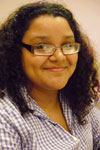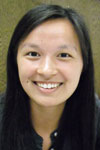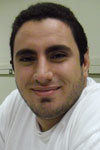A select group of undergraduates will have an advantage when applying for graduate schools, thanks to a School of Public Health summer program that gives them a chance to work in cutting-edge laboratories.
"We don't have labs like this in our home school, so experience like this is really helpful," said Lilian Turcios, a senior at Texas Southern University who spent nine weeks in Professor Michael Yost's lab in the Department of Environmental and Occupational Health Sciences.
Turcios, of Houston, was one of 11 students taking part in this year's Environmental Health Research Experience Program (EHREP) – a summer course for outstanding students from disadvantaged or under-represented groups. This year's students were chosen from a record 300 applicants.

Lilian Turcios
The program, which wraps up this week, is designed to spur students into careers in environmental and health sciences. But getting into graduate school is a first step, and the summer research program gives students an edge over other applicants, said Susan Inman, an adviser and recruiter for the program.
Each student receives a $5,200 stipend to cover living and travel costs for the program, and is placed in a DEOHS lab with leading faculty, staff and graduate students. The program, in its fifth year, is funded by the National Institute of Environmental Health Sciences. Students were chosen based on their academic credentials, recommendations and interest in environmental health.
Turcios spent her summer analyzing dust particles, ammonia and other contaminants taken from air samples near large-scale dairies and other animal-feeding operations in the Yakima Valley. The research is part of an ongoing epidemiological study on potential triggers of children's asthma. Turcios worked closely with PhD student Jenna Armstrong. "She's been a great mentor," Turcios said.
Turcios also learned an important reality: "It gets lonely in a lab. I never knew that." Friendship with other summer students – including trips to the Bite of Seattle and the Space Needle – made up for the isolation.
Students attended a weekly seminar about different topics and research areas in the field. "There were a lot of career paths I've never heard of," said Andrea d'Aquino of Bellingham, WA, who was inspired by Sheela Sathyanarayana, a pediatrician and environmental health researcher.

Andrea d'Aquino
D'Aquino, an incoming senior at Western Washington University, spent the summer on a project studying how air filters collect samples of ground-level ozone. "I hadn't had any real lab-based research experience," d'Aquino said. "I've learned so much." She plans to attend graduate school in chemistry or environmental health.
Hamza Rabi, a senior from Kent, WA, who attends the UW, didn't spend long hours in the lab. Instead, he got out into the communities of South Park and Georgetown in South Seattle several times a week. "You can put things into perspective when you're out there talking to people," he said.

Hamza Rabi
His project involved measuring particulate matter and nitrogen oxides – a byproduct of combustion – at various sites in the two neighborhoods, which are surrounded by freeways, Boeing Field, the Port of Seattle and other industries. "Particulate matter is heavier than air and gets trapped in the valley," Rabi said. "The people here have the highest asthma hospitalization rate in the entire county."
Rabi is a pre-med student whose research feeds into a larger study on diesel emissions overseen by Professor Joel Kaufman. Kaufman also runs the Multi-Ethnic Study of Atherosclerosis and Air Pollution (MESA Air), which is examining the relationship between air pollution and cardiovascular disease.
According to Adviser Inman, more than 90 percent of the 34 students who have taken part in EHREP's first four years expressed increased interest in going to graduate school in the sciences. The bulk of students moved on to graduate and professional school programs in environmental health, epidemiology, public health, immunology, dentistry, nursing and medicine. Several graduates received national recognition for their summer research projects.
"This program has been a win-win activity," said David Kalman, chairman and professor of the department of Environmental and Occupational Health Sciences. It's helped recruit students into the school's graduate programs while achieving a number of other goals, including reaching out to underserved populations and increasing diversity at the school, Kalman said.
Other students taking part in the 2012 EHREP program:
- Sheila Cubero-Rodriquez, senior, Universidad Del Este
- Mitra Geier, junior, Western Washington University
- Josi Herron, senior, University of Great Falls
- Madelyn Huang, senior, University of Notre Dame
- Alexandra Kossik, senior, University of Washington
- Siddarta Jairam, UC Santa Barbara
Two students from National Taiwan University, Ming-Fong Yang and Chi-Hsuan Chang, also took part. They were self-funded but received support from DEOHS staff and faculty.
